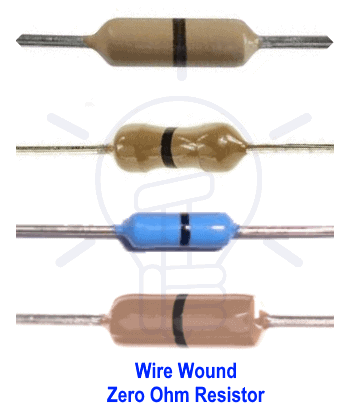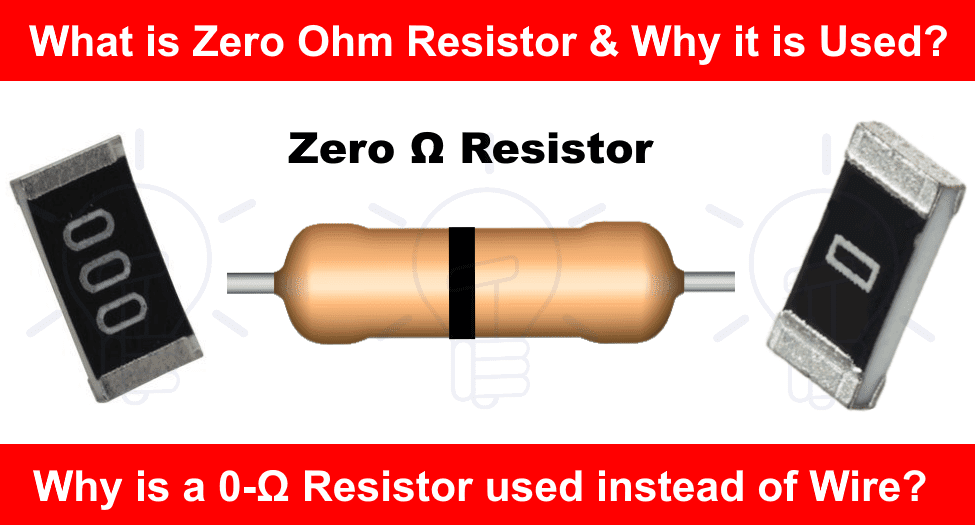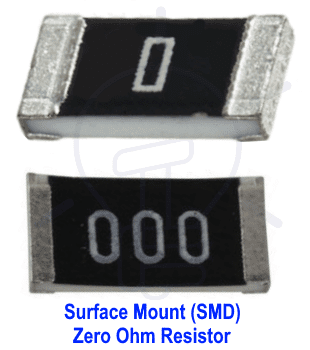Why is a Zero Ohm Resistor used instead of a Jumper Wire?
What is Zero Ohm Resistor?
A Zero Ohm Resistor (also known as Zero Ohm Link) is a passive device which has ideally “0 Ω” resistance like any other short wire and pure conducting materials.
0-Ω Resistor is a jumper or any other wire packaged the same like the shape of a resistor. It has almost 0-Ω resistance (although it has some resistance in real life as like other conducting materials and ± tolerance). Zero ohms resistors are available in a range such as 1/8W having 4mΩ and 1/4W having 3mΩ.
Many of us have seen these “Zero-Ohm” resistors in the modern PCB design and circuit. So one must ask about “What is the purpose of a zero ohm resistor and why 0-Ω Resistors are used instead of jumpers or wires?” Well, we will discuss the different reasons behind the story.
Types of Zero Ohm Resistors
Zero ohms resistors are available in the following two shapes.
- Wire Wound Zero Ohm Resistor
- Surface Mount (SMD) Zero Ohm Resistor
Wire Wound Zero Ohm Resistor
It is the general shape of an ordinary resistor. In the wire wound zero Ω ohm resistor, there is only and only one black line ( single black band) printed on the resistor. The single black strip o-ohm resistor is shown in the following fig.
Surface Mount (SMD) Zero Ohm Resistor
In the recent technology, surface mount resistors are used instead of wire wound or any other types of resistors due to the cost, simplicity and covered area of PCB board etc. In a zero ohm surface mount resistor, the manufacturer prints a “single zero “0” or “three zeros “000” on the surface. The single and three zeros labeled zero ohms resistors can be seen in the following fig.
Good to know: SMD stands for “Surface Mount Device”. We have discussed in the previous post about how to to find the value of SMD Resistors with color codes.
Why a Zero Ohm Resistor used instead of Wire?
There are multiple reasons to do so. Some of the zero ohm resistors application are as follow:
Automatic Placement by Insertion Machines
In PCB mass production, an automatic insertion machine is used to pick and place the components and devices such as diodes, capacitors, inductors, resistors etc. For the ease and reduce the production cost, it is an easy approach to use zero ohm resistors instead of wires and jumpers because you will have to manage another automatic wire placer machine or you will have to manually place it. In other words, you will have to use two machines, one for components and other one for wires and jumper which leads to a costly production and more time needed to fully assemble the PCB.
Single Layer PCB Design
A single layer PCB is less costly as compared to the double layer PCB design and assembly. To use wires in the single PCB assembly, you will have to make holes which turns it in double layer PCB. Instead of doing so, a 0-Ω resistor is the perfect match as compared to the wires and jumpers used in the single layer PCB structure. Hence, it reduces the overall cost again.
Preventing Copycats using Reverse Engineering
Yes, they exist. Copycats simply copy the well known PCB designs using reverse engineering tactics. In this case, zero ohm resistors are the best alternative to wires which confuse and prevent the copycats. To do so, designers and manufacturers put 0-Ω resistors with no marking or use different resistor color codes. This way, the chances of copying a PCB design are lesser with more efforts.
Should I Use a 0-Ω Resistor or Jumper Wire?
Well, if you are a hobbyist and just love making PCB designs and circuits for your own purposes, It is better to take the soldering iron and place a wire instead of picking those tiny so called 0-ohm resistors (they are having little bit resistance).
If you are doing mass production and working on a brand, you must use 0-Ω resistors instead of jumpers as all of your competitors are doing the same due to the above mentioned reason and advantages.
Related Post:
- How to Find the Value of Burnt Resistor ( By Four Handy Methods )
- Resistor Symbols – Variable, Adjustable & Special Resistors Symbols
- Resistor Color Code Calculator – 3, 4, 5 & 6 Band Resistors Calculation
- LED Resistor Calculator | Required Value of Resistor for LED’s Circuit Calculator
- Standard Resistor Closest Value Calculator
- Difference Between AC and DC Resistance – Which One is More?


 How Does a Standard Breaker Respond to Electrical Fault?
How Does a Standard Breaker Respond to Electrical Fault? Why Doesn’t a Standard Breaker Protract Against Ground Faults?
Why Doesn’t a Standard Breaker Protract Against Ground Faults? How Do GFCI and Standard Breakers Respond to Ground Faults?
How Do GFCI and Standard Breakers Respond to Ground Faults? What Happens if the Neutral is Lost in the Main or Subpanel?
What Happens if the Neutral is Lost in the Main or Subpanel? Why Must Neutral and Ground Wires Be Bonded in the Main Panel?
Why Must Neutral and Ground Wires Be Bonded in the Main Panel? Why are Neutral and Ground Wires Separated in a Subpanel?
Why are Neutral and Ground Wires Separated in a Subpanel?